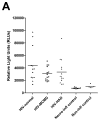Detection of anti-tat antibodies in CSF of individuals with HIV-associated neurocognitive disorders
- PMID: 23329164
- PMCID: PMC3593725
- DOI: 10.1007/s13365-012-0144-8
Detection of anti-tat antibodies in CSF of individuals with HIV-associated neurocognitive disorders
Abstract
Despite major advances in the development of antiretroviral therapies, currently available treatments have no effect on the production of HIV-Tat protein once the proviral DNA is formed. Tat is a highly neurotoxic and neuroinflammatory protein, but its effects may be modulated by antibody responses against it. We developed an indirect enzyme-linked immunosorbent assay and measured anti-Tat antibody titers in CSF of a well characterized cohort of 52 HIV-infected and 13 control individuals. We successfully measured anti-Tat antibodies in CSF of HIV-infected individuals with excellent sensitivity and specificity, spanning a broad range of detection from 10,000 to over 100,000 relative light units. We analyzed them for relationship to cognitive function, CD4 cell counts, and HIV viral load. Anti-Tat antibody levels were higher in those without neurocognitive dysfunction than in those with HIV-associated neurocognitive dysfunction (HAND) and in individuals with lower CD4 cell counts and higher viral loads. We provide details of an assay which may have diagnostic, prognostic, or therapeutic implications for patients with HAND. Active viral replication may be needed to drive the immune response against Tat protein, but this robust immune response against the protein may be neuroprotective.
Figures


Similar articles
-
HIV-Tat immunization induces cross-clade neutralizing antibodies and CD4(+) T cell increases in antiretroviral-treated South African volunteers: a randomized phase II clinical trial.Retrovirology. 2016 Jun 9;13(1):34. doi: 10.1186/s12977-016-0261-1. Retrovirology. 2016. PMID: 27277839 Free PMC article. Clinical Trial.
-
Association between different anti-Tat antibody isotypes and HIV disease progression: data from an African cohort.BMC Infect Dis. 2016 Jul 22;16:344. doi: 10.1186/s12879-016-1647-3. BMC Infect Dis. 2016. PMID: 27450538 Free PMC article.
-
Protocol for Detection of HIV-Tat Protein in Cerebrospinal Fluid by a Sandwich Enzyme-Linked Immunosorbent Assay.Methods Mol Biol. 2016;1354:343-52. doi: 10.1007/978-1-4939-3046-3_23. Methods Mol Biol. 2016. PMID: 26714723 Free PMC article.
-
Antibody to HIV-1 Tat protein, a key molecule in HIV-1 pathogenesis. A brief review.New Microbiol. 2001 Apr;24(2):197-205. New Microbiol. 2001. PMID: 11346305 Review.
-
Parallel conduction of the phase I preventive and therapeutic trials based on the Tat vaccine candidate.Rev Recent Clin Trials. 2009 Sep;4(3):195-204. doi: 10.2174/157488709789957529. Rev Recent Clin Trials. 2009. PMID: 20028332 Review.
Cited by
-
HIV-Associated Cardiovascular Disease: Role of Connexin 43.Am J Pathol. 2017 Sep;187(9):1960-1970. doi: 10.1016/j.ajpath.2017.05.011. Epub 2017 Jul 5. Am J Pathol. 2017. PMID: 28688235 Free PMC article.
-
HIV-1-Tat Protein Inhibits SC35-mediated Tau Exon 10 Inclusion through Up-regulation of DYRK1A Kinase.J Biol Chem. 2015 Dec 25;290(52):30931-46. doi: 10.1074/jbc.M115.675751. Epub 2015 Nov 3. J Biol Chem. 2015. PMID: 26534959 Free PMC article.
-
HIV-1 Tat: Role in Bystander Toxicity.Front Cell Infect Microbiol. 2020 Feb 25;10:61. doi: 10.3389/fcimb.2020.00061. eCollection 2020. Front Cell Infect Microbiol. 2020. PMID: 32158701 Free PMC article. Review.
-
Targeting HIV transcription: the quest for a functional cure.Curr Top Microbiol Immunol. 2015;389:121-45. doi: 10.1007/82_2015_435. Curr Top Microbiol Immunol. 2015. PMID: 25731772 Free PMC article. Review.
-
HIV-1 Tat Length: Comparative and Functional Considerations.Front Microbiol. 2020 Mar 24;11:444. doi: 10.3389/fmicb.2020.00444. eCollection 2020. Front Microbiol. 2020. PMID: 32265877 Free PMC article. No abstract available.
References
-
- Davis LE, Hjelle BL, Miller VE, Palmer DL, Llewellyn AL, Merlin TL, Young SA, Mills RG, Wachsman W, Wiley CA. Early viral brain invasion in iatrogenic human immunodeficiency virus infection. Neurology. 1992;42:1736–1739. - PubMed
-
- Dore GJ, McDonald A, Li Y, Kaldor JM, Brew BJ National HIVSC . Marked improvement in survival following AIDS dementia complex in the era of highly active antiretroviral therapy. AIDS (London, England) 2003;17:1539–1545. - PubMed
-
- Gonzalez E, Rovin BH, Sen L, Cooke G, Dhanda R, Mummidi S, Kulkarni H, Bamshad MJ, Telles V, Anderson SA, Walter EA, Stephan KT, Deucher M, Mangano A, Bologna R, Ahuja SS, Dolan MJ, Ahuja SK. HIV-1 infection and AIDS dementia are influenced by a mutant MCP-1 allele linked to increased monocyte infiltration of tissues and MCP-1 levels. Proceedings of the National Academy of Sciences of the United States of America. 2002;99:13795–13800. - PMC - PubMed
-
- Haughey NJ, Nath A, Mattson MP, Slevin JT, Geiger JD. HIV-1 Tat through phosphorylation of NMDA receptors potentiates glutamate excitotoxicity. Journal of neurochemistry. 2001;78:457–467. - PubMed
-
- Hudson L, Liu J, Nath A, Jones M, Raghavan R, Narayan O, Male D, Everall I. Detection of the human immunodeficiency virus regulatory protein tat in CNS tissues. Journal of neurovirology. 2000;6:145–155. - PubMed
Publication types
MeSH terms
Substances
Grants and funding
LinkOut - more resources
Full Text Sources
Other Literature Sources
Research Materials

